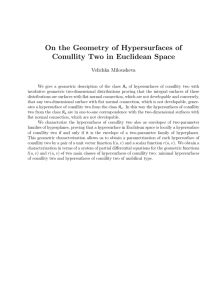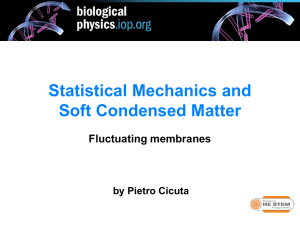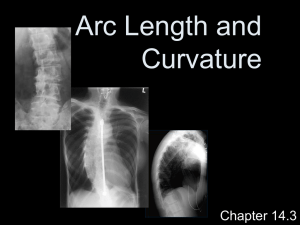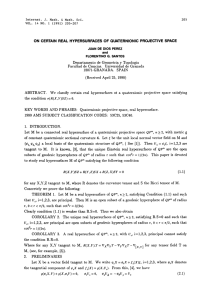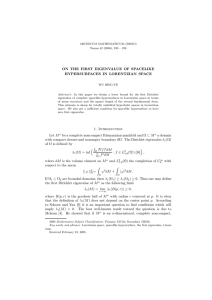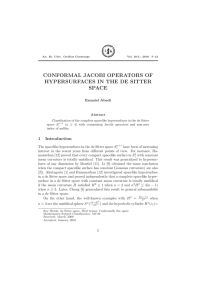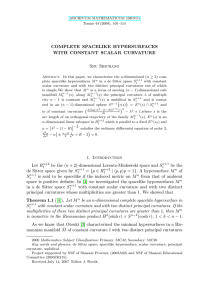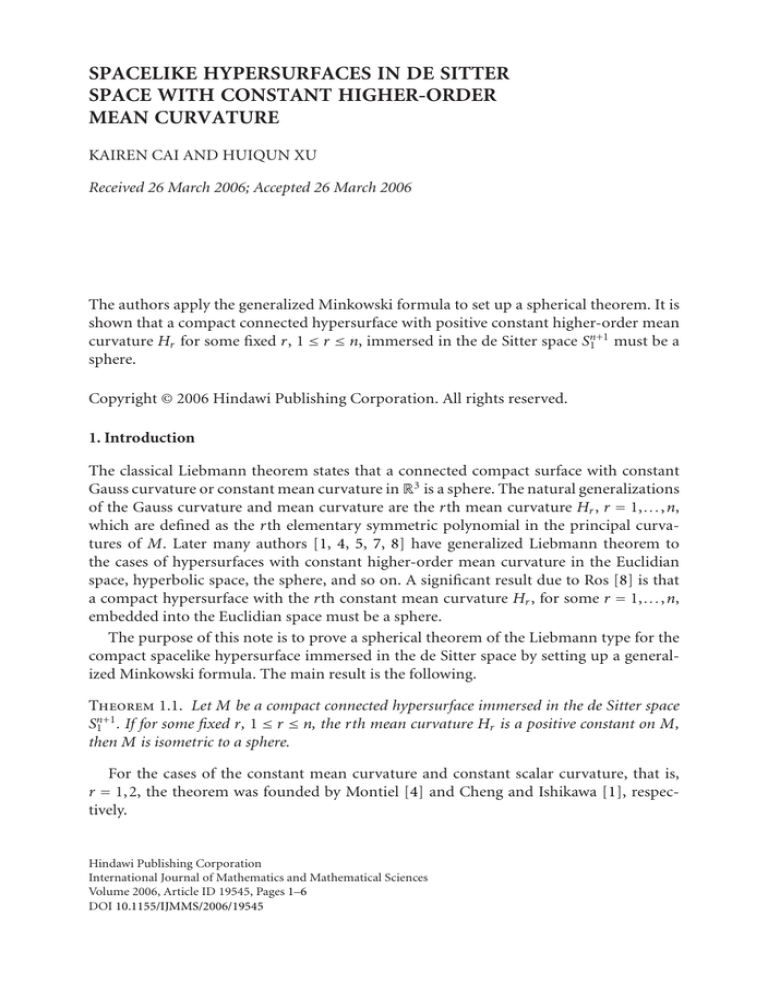
SPACELIKE HYPERSURFACES IN DE SITTER
SPACE WITH CONSTANT HIGHER-ORDER
MEAN CURVATURE
KAIREN CAI AND HUIQUN XU
Received 26 March 2006; Accepted 26 March 2006
The authors apply the generalized Minkowski formula to set up a spherical theorem. It is
shown that a compact connected hypersurface with positive constant higher-order mean
curvature Hr for some fixed r, 1 ≤ r ≤ n, immersed in the de Sitter space Sn+1
must be a
1
sphere.
Copyright © 2006 Hindawi Publishing Corporation. All rights reserved.
1. Introduction
The classical Liebmann theorem states that a connected compact surface with constant
Gauss curvature or constant mean curvature in R3 is a sphere. The natural generalizations
of the Gauss curvature and mean curvature are the rth mean curvature Hr , r = 1,...,n,
which are defined as the rth elementary symmetric polynomial in the principal curvatures of M. Later many authors [1, 4, 5, 7, 8] have generalized Liebmann theorem to
the cases of hypersurfaces with constant higher-order mean curvature in the Euclidian
space, hyperbolic space, the sphere, and so on. A significant result due to Ros [8] is that
a compact hypersurface with the rth constant mean curvature Hr , for some r = 1,...,n,
embedded into the Euclidian space must be a sphere.
The purpose of this note is to prove a spherical theorem of the Liebmann type for the
compact spacelike hypersurface immersed in the de Sitter space by setting up a generalized Minkowski formula. The main result is the following.
Theorem 1.1. Let M be a compact connected hypersurface immersed in the de Sitter space
Sn+1
1 . If for some fixed r, 1 ≤ r ≤ n, the rth mean curvature Hr is a positive constant on M,
then M is isometric to a sphere.
For the cases of the constant mean curvature and constant scalar curvature, that is,
r = 1,2, the theorem was founded by Montiel [4] and Cheng and Ishikawa [1], respectively.
Hindawi Publishing Corporation
International Journal of Mathematics and Mathematical Sciences
Volume 2006, Article ID 19545, Pages 1–6
DOI 10.1155/IJMMS/2006/19545
2
Spacelike hypersurfaces in de Sitter space
2. Preliminaries
be the real vector space Rn+2 endowed with the Lorentzian metric ·, · given by
Let Rn+2
1
x, y = −x0 y0 +
n+2
xi y i
(2.1)
i =1
for x, y ∈ Rn+2 . The de Sitter space Sn+1
1 (c) can be defined as the following hyperquadratic:
1 1
n+2
| |x|2 = , > 0 .
Sn+1
1 (c) = x ∈ R1
c c
(2.2)
In this way, the de Sitter space inherits from ·, · a metric which makes it an indefinite
Riemannian manifold of constant sectional curvature c. If x ∈ Sn+1
1 (c), we can put
n+2
| v,x = 0 .
Tx Sn+1
1 (c) = v ∈ R1
(2.3)
be a connected spacelike hypersurface immersed in the de Sitter space
Let ψ : M → Sn+1
1
with the sectional curvature 1. Following O’Neill [6], the unit normal vector field N for
ψ can be viewed as the Gauss map of M:
N : M −→ x ∈ Rn+2
| |x|2 = −1 .
1
(2.4)
Let Sr : Rn → R, r = 1,...,n, be the normalized rth elementary symmetric function in
the variables y1 ,..., yn . For r = 1,...,n, we denote by Cr the connected component of
the set { y ∈ Rn | Sr (y) > 0} containing the vector y = (1,...,1). Notice that every vector (y1 ,..., yn ) with all its components greater than zero lies in each Cr . We derive the
following two lemmas, which will be needed for the proof of the theorem.
Lemma 2.1 [3]. (i) If r ≥ k, then Cr ⊂ Ck ; (ii) for y ∈ Cr ,
1/r −1
1/2
S1/r
r ≤ S r − 1 ≤ · · · ≤ S 2 ≤ S1 .
(2.5)
⊂ Rn+2
be a connected spacelike hyLemma 2.2 (Minkowski formula). Let ψ : M → Sn+1
1
1
n+1
persurface immersed in de Sitter space S1 . For the rth mean curvature Hr of ψ, r = 0,1,...,
n − 1,
M
Hr ψ,a + Hr+1 N,a dV = 0,
(2.6)
where H0 = 1 and a ∈ Rn+1
1 is an arbitrary fixed vector and N is the unit normal vector of M.
Proof. The argument is based on the approach of geodesic parallel hypersurfaces in [5].
Let kr and ei , i = 1,...,n, be the principal curvatures and the principal directions at a
point p ∈ M. The rth mean curvature of ψ is defined by the identity
Pn (t) = 1 + tk1 · · · 1 + tkn
n
n
H1 t + · · · +
Hn t n
= 1+
1
n
(2.7)
K. Cai and H. Xu
3
for all t ∈ R. Thus H1 = H is the mean curvature, H2 = (n2 H 2 − S)/n(n − 1), where S is
the square length of the second fundamental form and Hn is the Gauss-Kronecker curvature of M immersed in Sn+1
1 . Let us consider a family of geodesic parallel hypersurfaces ψt
given by
ψt (p) = expψ(p) − tN(p) = cosht · ψ(p) + sinht · N(p).
(2.8)
Then the unit normal vector field of ψt with |Nt |2 = −1 can be written as
Nt (p) = − sinht · ψ(p) − cosht · N(p).
(2.9)
Because we have
ψt∗ ei = cosht − ki sinht ei ,
(2.10)
Nt∗ ei = − sinht + ki cosht ei ;
for the principal directions {ei }, i = 1,...,n and |t | < ε, the second fundamental form of
ψt can be expressed as
σt ψt∗ ei ,ψt∗ e j
= − Nt∗ ei ,ψt∗ e j
= sinht − ki cosht ei ,ψt∗ e j
sinht − ki cosht ψt∗ ei ,ψt∗ e j .
=
cosht − ki sinht
(2.11)
Then the mean curvature H(t) of ψ can be expressed as
1
1 tanht − ki
ki (t) =
n i =1
n i=1 1 − ki tanht
n
H(t) =
n
1
=
tanht − ki
1 − k j tanht .
nPn (− tanht) i=1
j =i
n
(2.12)
But
1 − k j tanht = nPn (− tanht) − cosht sinht Pn (− tanht).
(2.13)
j =i
Then we get
H(t) = tanht +
Pn (− tanht)
.
nPn (− tanht)
(2.14)
By the way, we must point out that the formula (7 ) in [5] is incorrect because the second
term in the right-hand side of the expression of H(t) should be Pn (tanht)/nPn (tanht).
The volume element dVt for immersion ψt can be given by
dVt = cosht − k1 sinht · · · conht − kn sinht dV
n
= − conh t Pn (− tanht)dV ,
(2.15)
4
Spacelike hypersurfaces in de Sitter space
where dV is the volume element of ψ. It is an easy computation that
ψ,a + H N,a = 0,
(2.16)
an arbitrary fixed vector (cf. [4, page
where N is a unit normal field of ψ and a ∈ Rn+2
1
914]). Integrating both sides of (2.16) over the hypersurface M and applying Stoke’s theorem, we get
M
ψ,a + H1 N,a dV = 0.
(2.17)
For ψt , |t | < ε, we obtain
M
ψt ,a + H(t) Nt ,a dVt = 0.
(2.18)
Substituting (2.14) and (2.15) into (2.18), we get
M
ψt ,a + H(t) Nt ,a dVt
1
n −1
= cosh
t
n
nPn (− tanht) − sinht coshtPn (− tanht) ψ,a
M
(2.19)
2
− cosh tPn (− tanht)N,a dV = 0.
By using the expression
nPn (− tanht) − sinht coshtPn (− tanht)
n
n
= n + (n − 1)
H1 (− tanht) + · · · + n
Hn (− tanht)n−1 ,
1
n−1
(2.20)
we obtain
M
=
M
nPn (− tanht) − sinht cosht Pn (− tant) ψ,a − conh2 tPn (− tanht)N,a dV
n
(n − r − 1)
r =1
n
r −1
(− tanht)r −1 ,
Hr −1 ψt ,a + Hr Nt ,a dV = 0.
(2.21)
The left-hand side in the equality is a polynomial in the variable tanht. Therefore, all its
coefficients are null. This completes the proof of Lemma 2.2.
3. Proof of Theorem 1.1
instead of embedded hypersurfaces
Here we work for the immersed hypersurfaces in Sn+1
1
because we can only use algebraic inequalities and the integral formula above to complete the proof. Let some Hr be a positive constant. Multiplying (2.17) by Hr and then
K. Cai and H. Xu
5
abstracting from (2.6), we obtain that
M
H1 Hr − Hr+1 N,adV = 0.
(3.1)
We know from Newton inequality [2] that Hr −1 Hr+1 ≤ Hr2 , where the equality implies
that k1 = · · · = kn . Hence
Hr −1 H1 Hr − Hr+1 ≥ Hr H1 Hr −1 − Hr .
(3.2)
It derives from Lemma 2.1 that
−1
1/2
0 ≤ Hr1/r ≤ Hr1/r
−1 ≤ · · · ≤ H 2 ≤ H 1 .
(3.3)
Thus we conclude that
Hr −1 H1 Hr − Hr+1 ≥ Hr H1 Hr1 − Hr ≥ 0,
(3.4)
and if r ≥ 2, the equalities happen only at umbilical points of M. We choose a constant
vector a such that |a|2 = −1 and a0 ≤ −1. Since the normal vector N satisfies |N |2 = −1,
we have N,a ≥ 1 on M. It follows from (3.1) that
H1 Hr − Hr+1 = 0.
(3.5)
Thus, k1 = · · · = kn , M is totally umbilical, and M is isometric to a sphere. This ends the
proof of Theorem 1.1.
If there is a convex point on M, that is, a point at which ki > 0, for all i = 1,...,n, then
the constant rth mean curvature Hr is positive. By means of the same argument as that of
Theorem 1.1, we derive the following.
Corollary 3.1. Let M be a compact connected hypersurface immersed in the de Sitter space
Sn+1
1 . If for some fixed r, 1 ≤ r ≤ n, the rth mean curvature Hr is constant, and there is a
convex point on M, then M is isometric to a sphere.
Acknowledgment
The project is supported by the Natural Science Foundation of Zhejiang Provence in
China.
References
[1] Q.-M. Cheng and S. Ishikawa, Spacelike hypersurfaces with constant scalar curvature, Manuscripta Mathematica 95 (1998), no. 4, 499–505.
[2] J. Eells Jr. and J. H. Sampson, Harmonic mappings of Riemannian manifolds, American Journal
of Mathematics 86 (1964), 109–160.
[3] L. Gȧrding, An inequality for hyperbolic polynomials, Journal of Mathematics and Mechanics 8
(1959), 957–965.
[4] S. Montiel, An integral inequality for compact spacelike hypersurfaces in de Sitter space and applications to the case of constant mean curvature, Indiana University Mathematics Journal 37 (1988),
no. 4, 909–917.
6
Spacelike hypersurfaces in de Sitter space
[5] S. Montiel and A. Ros, Compact hypersurfaces: the Alexandrov theorem for higher order mean
curvatures, Differential Geometry. Proceedings Conference in Honor of Manfredo do Carmo,
Pitman Monogr. Surveys Pure Appl. Math., vol. 52, Longman Scientific & Technical, Harlow,
1991, pp. 279–296.
[6] B. O’Neill, Semi-Riemannian Geometry. With Applications to Relativity, Pure and Applied Mathematics, vol. 103, Academic Press, New York, 1983.
[7] R. C. Reilly, Applications of the Hessian operator in a Riemannian manifold, Indiana University
Mathematics Journal 26 (1977), no. 3, 459–472.
[8] A. Ros, Compact hypersurfaces with constant higher order mean curvatures, Revista Matemática
Iberoamericana 3 (1987), no. 3-4, 447–453.
Kairen Cai: Department of Mathematics, Hangzhou Teachers College, 222 Wen Yi Road,
Hangzhou 310036, China
E-mail addresses: kcai53@hotmail.com; kairencai408@hzcnc.com
Huiqun Xu: Department of Mathematics, Hangzhou Teachers College, 222 Wen Yi Road,
Hangzhou 310036, China
E-mail addresses: huiqunxhu@hotmail.com; xuhuiqun@163.com

